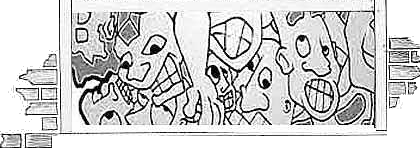Some interesting news on the Perkins front since the publication of my earlier DNA articles. I found a male Perkins cousin (let’s call him LP) who is a second cousin to my mother, WAB, and her sister JB. They all share a common ancestor of Jacob and Jennie (Jardine) Perkins. LP showed up on ancestryDNA through his autosomal DNA, and he was kind enough to submit to Y-DNA testing through familytreeDNA. Y-DNA is passed only from father to son. With it, you can compare DNA from other male Perkins ancestors, including and beyond John Perkins who sailed to Massachusetts in 1631. Below are the top 10 matches listed by familytreeDNA for LP’s Y-DNA
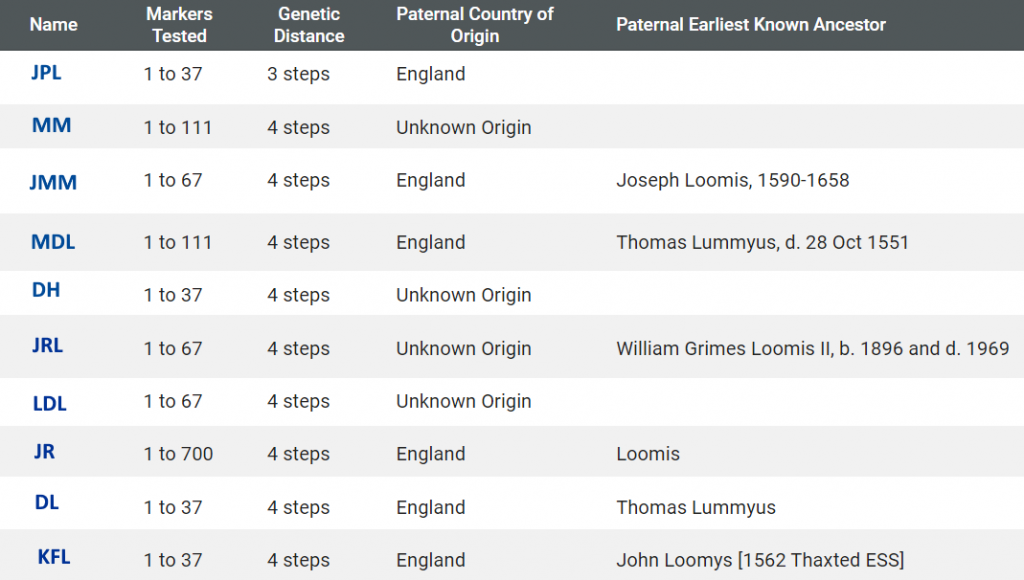
Whoops. Across the board, the testers name the earliest know ancestors as a “Loomis” not a “Perkins”. Shock, led to disbelief, then sadness since I really enjoyed researching all the members of the Perkins branch. With acceptance, I am finally able to study the results.
Out of a total of 37 test points, the closest match is 34/37. Ideally, all Y-DNA moves perfectly through the generations from father to son. However, mutations happen. Generally, the more generations, the more mutations. In this case 3 to 4 mutations occurred between a given Loomis men in the table and our LP. So the results suggest that the common Loomis male occurred many generations ago because it takes time for Y-DNA to mutate. How long ago? It’s all statistics as shown by the table to the right.
If you take the first match in the list, JPL, there is roughly 50% chance they share a common father after 6 generations. For reference, there are 13 generations from LP to John Perkins of Ipswich. So this DNA suggests that there about 93% chance that JPL and LP share a common father within those 13 generations. Stated another way, it’s highly likely one of these Perkins males listed below had a Loomis father.
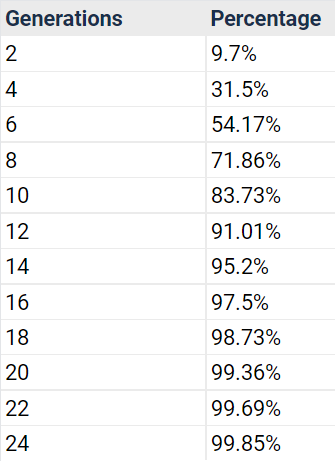
Now, let’s look at LP’s autosomal DNA results in the form of the ancestry Thrulines. As noted in a previous article (“DNA of WAB, Pt 1”), Thrulines combines user submitted tree with shared DNA to form descendant trees. While not perfect, due primarily to faulty trees, they do show shared matches down to 8 cM which is really helpful for these distant ancestors. Notice that Ely’s children show lots of matches, but his father, Francis Perkins, shows none.
This result may be significant, but it fails to prove that Ely is unrelated to Francis because there are other viable explanations. The autosomal DNA may have become too diluted below 8 cM. More importantly, Ely needs to have a sibling with descendants. In Ely’s case, we know of two brothers: Rev. Cyrus Peck Perkins and Dr. William Francis Perkins. There doesn’t not seem to be many testing descendants for either one.
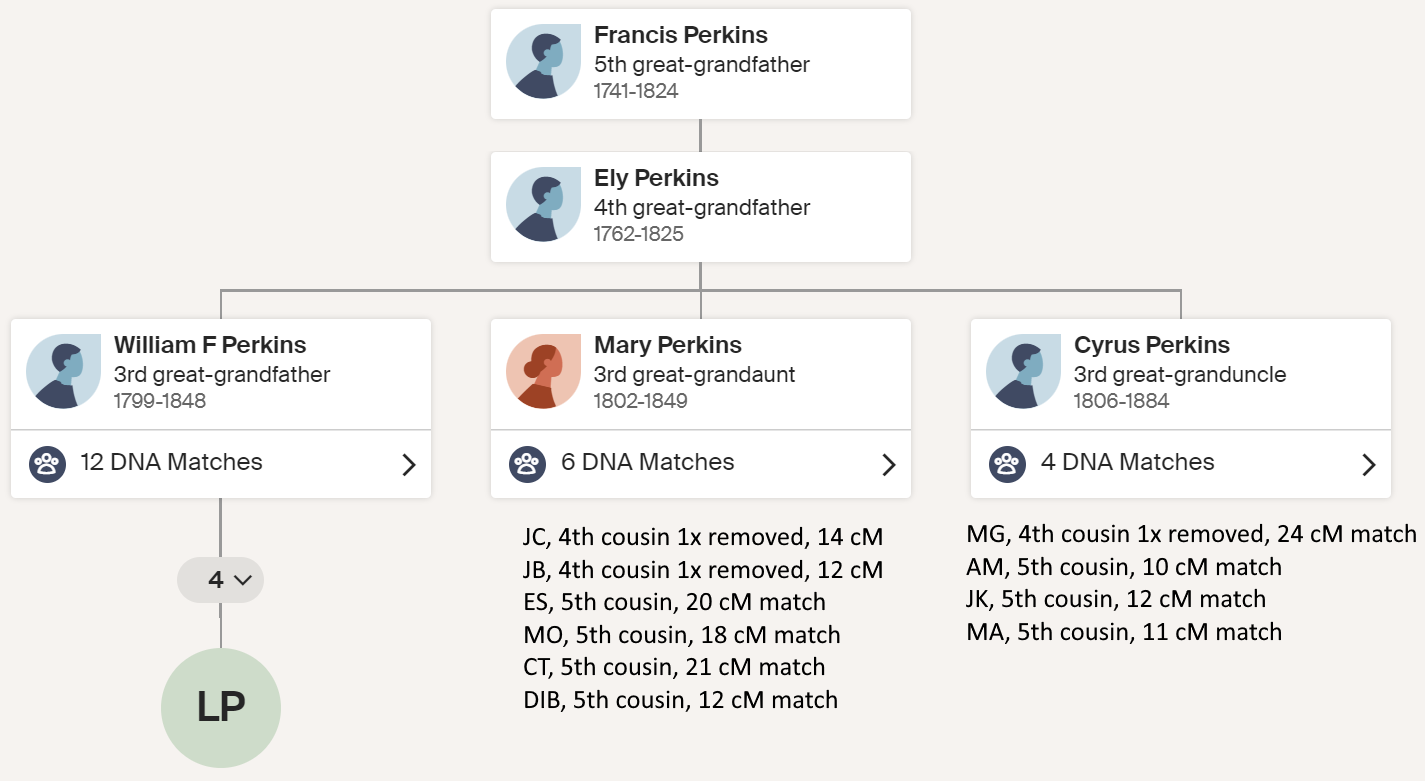
The migration of Francis and Elizabeth to Nova Scotia in 1762 became the source of family legend. Edmund Cogswell, grandson of Ely and Sarah (DeWolf) Perkins, lived with his Grandmother until Sarah died in 1865 . He wrote to his cousin in Jamaica in 1886. This letter eventually made it way into the Jamaican archives.
This same story made its way in the 1909 book “The Descendants of Edward Perkins of New Haven, Conn.” The author, Caroline Perkins, found additional descendants to expand the story to include all the Perkins family members who first moved to Lyme.
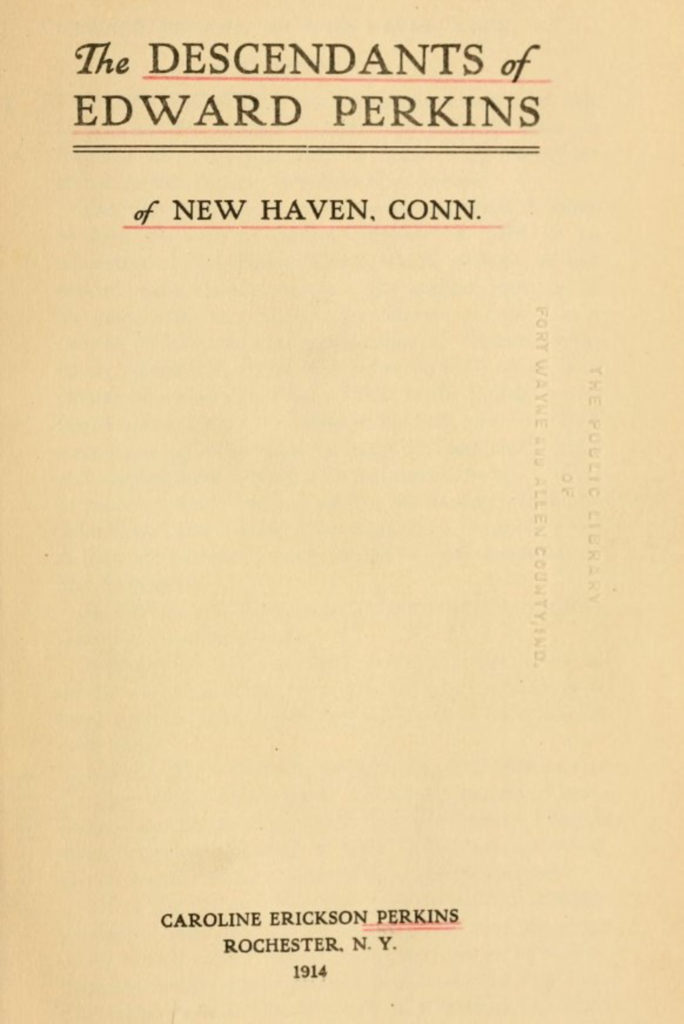
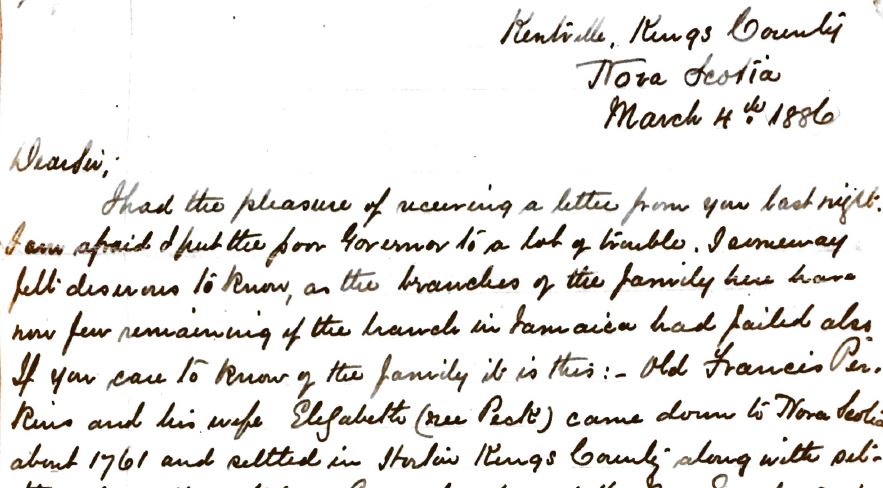
How to make sense of this data? At this point, based on the DNA and the paper evidence, I feel confident that children from Ely and Sarah (DeWolf) Perkins onwards are part of the Perkins genealogy. On the other hand, Ely himself remains problematic, and could be the son of a Loomis. If you go back to the 13 generation chart above, you can now limit the search to Ely, Francis, Abraham b. 1713, Abraham b. 1671, Isaac b. 1650, John b. 1608 and John b. 1583 as males Perkins being born by a male Loomis.
Now let’s look at the Loomis side of the equation. Based on the movements of the the Perkins men, we need a Loomis living nearby to either Ipswich, MA or Lyme, CT. Best-known is Joseph Loomis who arrived in America in 1638 before settling in Windsor, Connecticut. The 10 testers in the Y-DNA list all seem connected to him. Research of the tree suggests that Joseph goes back to Essex county in England in the 1500’s. While not many Loomises can be found in Lyme, many settled as close as Colchester located in northwest New London county. From the epic “The family of John Perkins of Ipswich, Massachusetts” by George Perkins, 1882, notice this cryptic mention of Colchester:
“245 Francis (Abraham, Abraham, Isaac, John, John ) was born in Lyme, Conn., on Monday, Dec. 14, 1741. He married — Lee, of Colchester, Conn. He is said to have removed to Halifax, N.S., and afterwards to Haston (?).”
Francis actually married a Peck (not a Lee), and they went to Horton (not Haston), but she could have been living in Colchester. On the other hand, there is also an Ipswich, MA angle to consider. From the equally epic “Descendants of Joseph Loomis in America: And His Antecedents in the Old World.” by Elias Loomis, 1909, we see this passage:
“Other families of the Loomis Name. – Besides the descendants of Joseph Loomis of Windsor, there are in the United States other families known by the name of Loomis, Lummis, or Lomas. Edward Lomas, born about 1606, came from London in 1635, and settled in Ipswich, Mass.;”
So we have an early Loomis arriving 1635 in Ipswich. Research indicates that this Edward also emigrated from Essex county in England, and is related to Joseph Loomis of Windsor. Unfortunately, there appears to be no individuals in the Loomis Y-DNA database who claim a tie with Edward. We can, at least, rule out John Perkins b. 1583 and John Perkins b. 1608 since they were born in Warwick county, far from Essex.
At this point, LP and I made contact with Howard Loomis who oversees the Loomis Y-DNA website. He convinced LP to expand his 37 test result to the “Big Y” which, as the name implies, is very big and comprehensive. Not only was the STR marker count increased from 37 to 111, but a new type of mutation, called a SNP, got tested as well. Below are the top matches at 111 SNP test points to LP. The “winner” of the closest match is MDL. JPL, closest match from the 37 test, does not show up because his test does not include 111 markers.
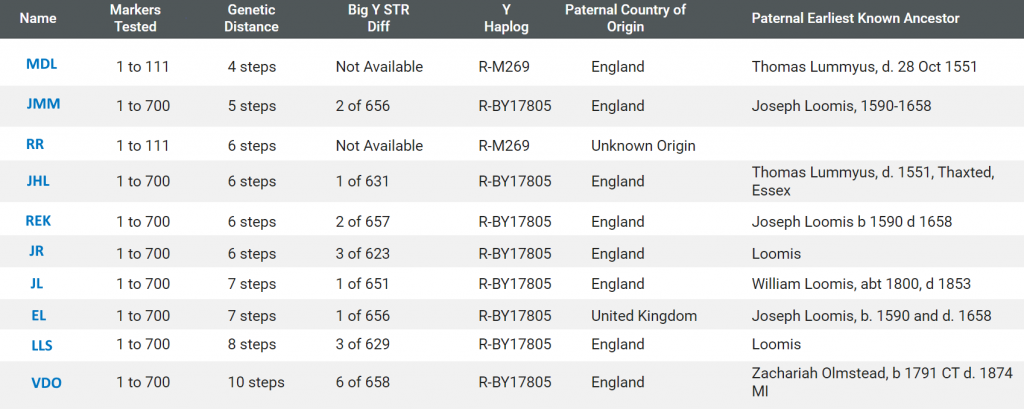
The Case for a Colchester Loomis
If we look at the tree of these closest matches, we see the Colchester Loomis names. To the right are the male linage for MDL, the best 111 test match and JPL, the best 37 test match. Two Perkins men, Frances and Ely, were born in Lyme. Two Loomis men, Daniel and John, were living in Colchester around the same time.
There is more. The nexus between Loomis of Colchester and Perkins of Lyme centers around the Peck family. Francis Perkins married Elizabeth Peck before they travelled with some of Elizabeth’s family to Nova Scotia. In Wesley Brown Church located in Salem, CT, lie the burial stones of Elizabeth’s father, Benjamin, and her brother, Elias. Also buried there in 1811 is John Loomis. You can see these cemetery listings in the link below, which includes a map showing Salem located between Colchester and Lyme:
Wesley Brown Cemetery Burials
I have to say that this evidence points to Ely being a possible child of a Loomis father, so allow me to focus on him for a bit. Ely was the oldest of three sons born about 1762 to Frances and Elizabeth (Peck) Perkins. He was likely named (some irony here) for Francis’ mother, Elizabeth (Ely) Perkins, who died a few years earlier in 1759. His parents were in the middle of moving from Lyme, Connecticut to Horton, Nova Scotia. His next brother, William Francis Perkins, would have been born seven years later in Nova Scotia. The third brother, Cyrus Perkins, was born another seven years later. There is no record of any of these births. However, they are all named in their father’s will. William Francis Perkins became a doctor, and moved to Jamaica where many descendants live today including elusive Y-DNA worthy males. Cyrus Perkins joined the Church of England, and settled in Annapolis, Nova Scotia. Not a lot of descendants survive from this line. Most connect to the Goucher surname with no male Perkins remaining.
I have been working with a Jamaican descendant of Dr. William Francis Perkins in hopes of connecting Francis to Ely. JLS has been kind enough to let me analyze her DNA. Jamaica genealogy research is hard. Records are not as good, and not as many people have tested. However, that said, we are beginning to see a DNA picture emerge. To date, the only Perkins ThruLine connects Henry Perkins son of Dr W F Perkins. The doctor has other lines, but I have not found any DNA links to them yet.
There is an open offer of free Y-DNA testing to any male Perkins willing to test.
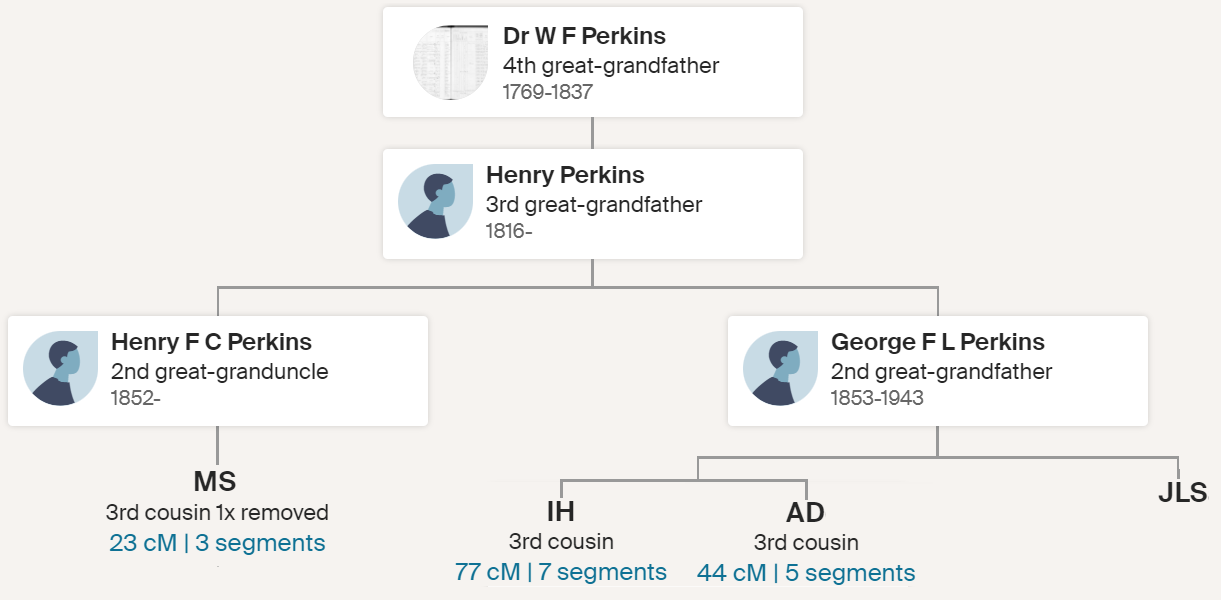
The Case for an Ipswich Loomis
The Colchester connection seems so obvious – until it doesn’t. To understand an alternative theory, we need a quick tutorial about Y-DNA mutations. The STR (short tandem repeat) serves as the basis of the 37, 67 and 111 marker Y-DNA tests. It is a count of the number of times that a small snippet of DNA repeats at a given marker. In the table below I have published the STR data for LP and nine close matches who also happen to have a published tree. Most of the marker counts remain constant. When a mutation occurs, the count will increase or decease by 1. Ideally, a STR mutation would signal a branch in the family tree. Let’s call that a “branch mutation”. For example, at marker 55, the three individuals in red (our LP, JHL and MDL) might all represent a single branch in the Loomis tree. Unfortunately, it does not always work out that way. (1) A mutation that goes up one can turn around and go back down one, making it look like no change happened. (2) Mutations can occur in parallel. That is, a same marker can change in separate branches. Let’s call them a “parallel mutation”.
These parallel mutations can drive you crazy. Here’s my way of dealing with them. The rate of mutation varies with the marker. The table to the right shows the list of relevant markers ranked in terms of mutation rate. For example, you can see that markers 34 and 35 mutate frequently. These high mutation rate markers are most likely to create parallel mutations. On the other hand, makers with low mutation rate are likely associated with branch mutation.
I assumption that the top 5 marker could easily produce parallel mutations. It makes little sense to force a branch out of them. For the rest, I try and make them branch mutations, if possible.
By the way, the rate of change for markers 34 and 35 is so high that I arbitrarily decided to exclude these markers from my analysis below. It does not add any understanding.
| Marker Number | Marker Name | Rank (out of 111) | Mutation Rate per Generation | Total Mutations |
|---|---|---|---|---|
| 34 | CDYa | 1 | 0.01877 | 4 |
| 35 | CDYb | 2 | 0.01877 | 3 |
| 94 | 712 | 3 | 0.01877 | 1 |
| 21 | 449 | 4 | 0.00939 | 2 |
| 32 | 576 | 5 | 0.00939 | 1 |
| 55 | 534 | 10 | 0.00626 | 3 |
| 9 | 439 | 13 | 0.00469 | 2 |
| 24 | 464c | 15 | 0.00469 | 1 |
| 78 | 549 | 18 | 0.00469 | 1 |
| 12 | 389ii-i | 28 | 0.00313 | 1 |
| 29 | YCAIIb | 51 | 0.00171 | 1 |
Howard fed all of the Loomis results in a sophisticated computer program called SAPP which creates a tree based on the sequence and rates of mutations. SAPP consistently predicts that the common ancestor between LP and the other matches occurs further back in time than Colchester. In order words, this computer program predicts an Ipswich Loomis for our ancestor. To understand this result, I created two scenerios, a Colchester Loomis and an Ipswich Loomis, with the known trees of the subgroup in the table above and with markers 34 & 35 omitted. In the first scenerio, I put Ely as a son as early as John Loomis b. 1741 of Colchester, that scenario left many mutations to occurs over a short period of time. An Ipswich Loomis would give the superior timeframe for the mutation to occur.
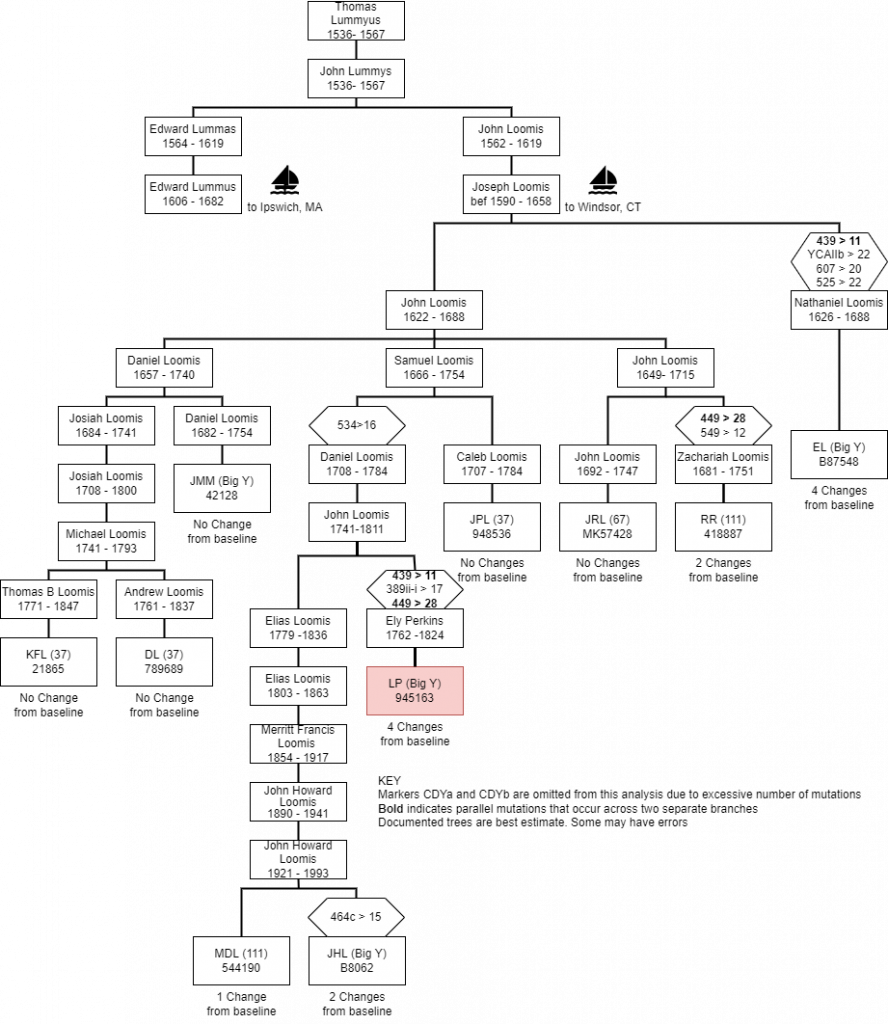
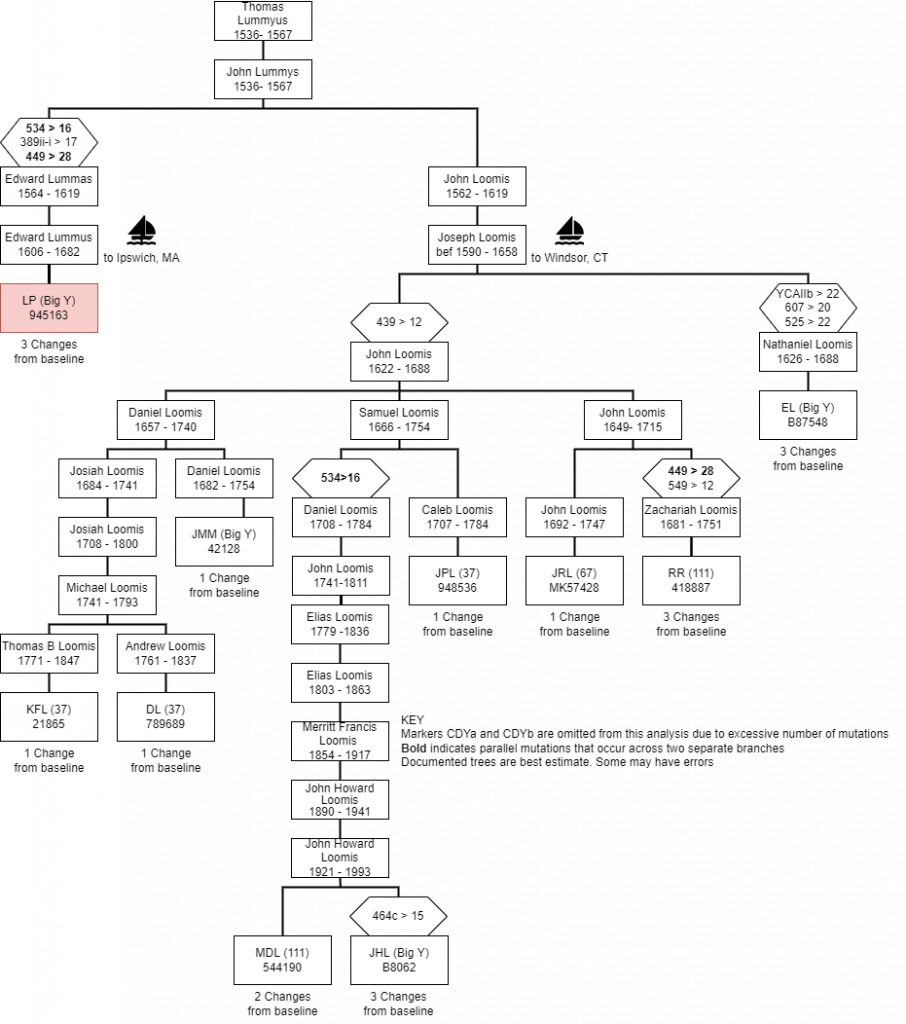
This conclusion would point to either Isaac b. 1650, Abraham b. 1671 or Abraham b. 1713 as being the son of a Loomis. The paper trail is too thin to name a suspect (so to speak) at this point. As we get closer to the original John Perkins, we should hopefully see some overlap with testers in the Perkins Y-DNA website.
There is another form of mutation that is part of the Big Y test. It is called a SNP (single-nucleotide polymorphism). These mutations stay put and are unique. But they tend to occur less frequently and therefore go back further in time. The sequence of SNP’s defines your haplogroup. LP’s is a R-BY17805. It occurred sometime after the year 1600. Since the Loomis men arrived to America about this same time, it is impossible to use this information to differentiate a Windsor Loomis from an Ipswich Loomis. However, the result is still important because it proves that LP belongs with the Ipswich/Windsor Loomis men.
The Y-DNA analysis continues to evolve, so anticipate changes to this article as new results, including Y-DNA, emerge. As mentioned, there is a standing offer to provide a test to any male Perkins or Loomis who could add to this body of evidence.
